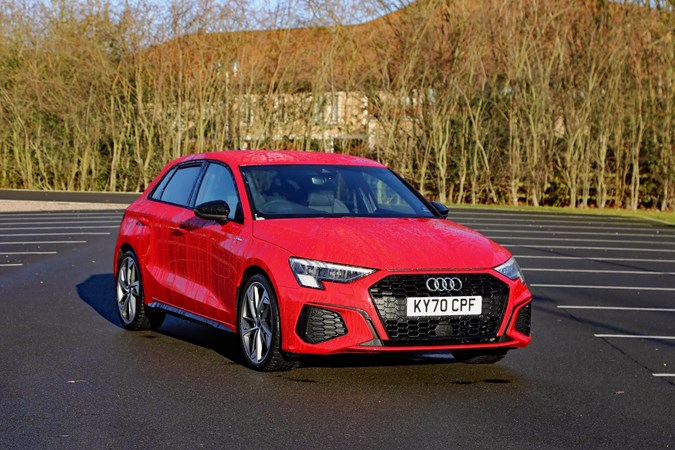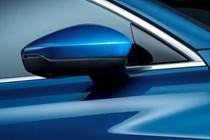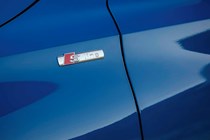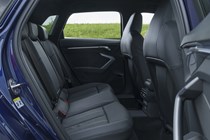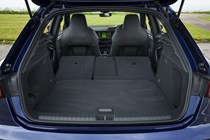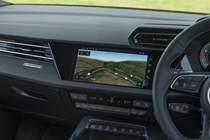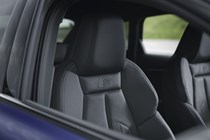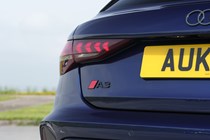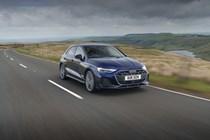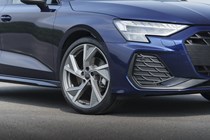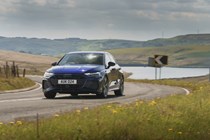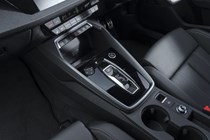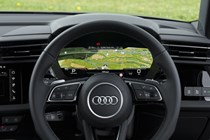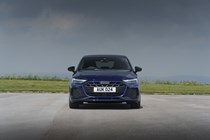Audi A3 long-term test
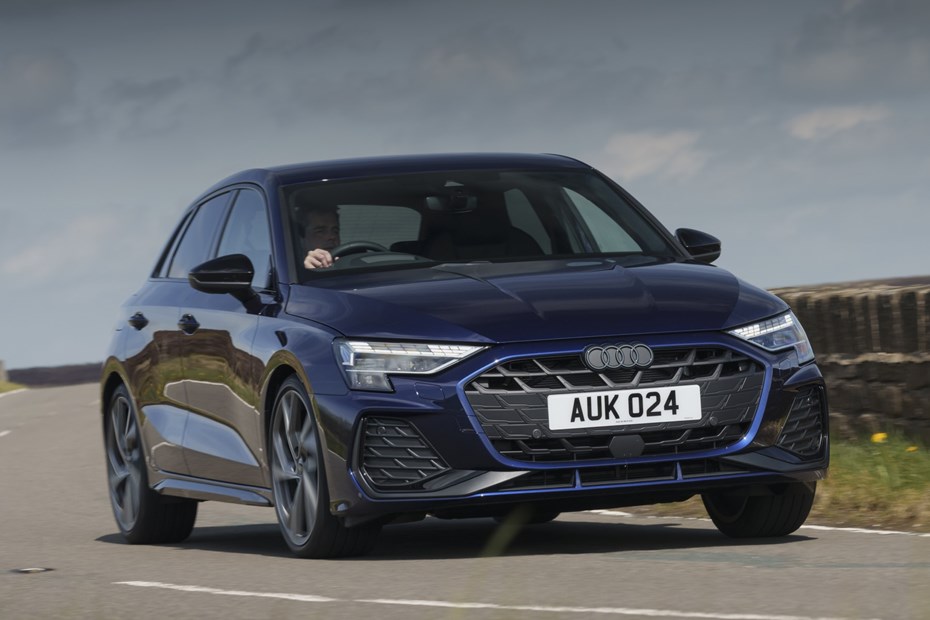
Murray Scullion on living with Audi’s latest premium family hatchback on a long-term test. This review is broken down into chapters – use the links below to navigate between them if you don’t fancy reading the whole article.
Update 1: Welcome
Update 2: Performance and handling
Update 3: Comfort and interior
Update 4: Practicality
Update 5: Head-to-head
Update 6: Would I recommend one?
Update 1: Welcome
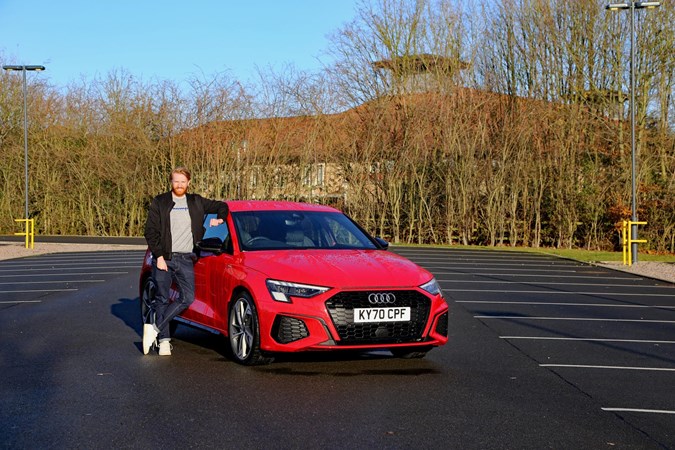
Welcome to the long-term report of the Audi A3. If you’ve made it this far into the review, you must be really keen as mustard.
A long-term report follows the life and times of a car, usually for around six months.
The main thing we really want to get down to the bottom of is whether the A3 is worth the premium over mechanically similar Volkswagen Group rivals such as the Volkswagen Golf, SEAT Leon, and Skoda Octavia.
Each car is supposed to have its own little niche. The Golf is the de facto choice, the SEAT is a bit cheaper, while the Skoda is more practical. The Audi is supposed to be the most premium, filled with high quality bits.
Well, at around £4,000, or £100 more a month than a similarly equipped Golf, is it worth the extra money?
We’ll also be answering other important questions regarding its practicality and stuff-carrying abilities, plus, pitching it head to head with some rivals. Like the sound of that? Cracking.
What about the spec?
It’s an Edition 1 model. This is one of those limited edition specs that’s only available for a short period of time after the car is released. It sits below top-of-the-range Vorsprung.
This new A3 looks an awful lot like the old car, but it’s tauter and far more modern. The side profile is especially interesting – the creases along the flanks and slightly flared arches are just the right side-of bad-ass for a family grocery-getter. Same for the wheels – these Edition 1 models come with 19-inch alloys that really fill those arches.
The metallic Tango Red is a £575 option and is a worthwhile addition in my eyes. In a sea of whites and silvers on the motorway it feels good to have something so bright. The metallic really pops in the right sunlight too.
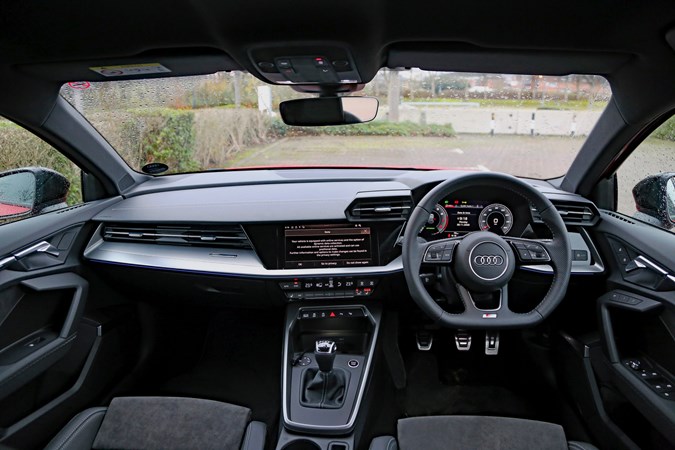
Engine?
It has Audi’s 35 TFSI petrol engine. In old money it’s a turbocharged 1.5-litre, making 150hp and 250Nm of torque.
It seems up to the task, but I’ll report more later once I’ve used it a bit more. Another question time here – is 150hp enough to pull around a 1400kg car and not be slow and annoying?
The 0-62mph time of 8.4seconds is more than reasonable, as is its official MPG rating of 50.4mpg.
This engine is pretty clever too. It can turn off two out of four cylinders to conserve fuel. Plus, it’s a mild-hybrid. This means it can harvest energy wasted when braking or coasting and pump it back into a belt-driven battery. It can’t run on pure electricity, but it can deploy bits of electricity to aid acceleration or MPG.
It should be noted that it’s a six-speed manual. As a classic car enthusiast and lover of mechanical stuff, this makes me very happy. Especially at a time when automatics are catching up with manual sales in the UK.
Highlights of our car:
Right then, we’ve established the spec of the car is spot on. Here are some highlights from Edition 1 spec:
> 19-inch ‘5-arm trapezoid’ alloy wheels
As mentioned, we also opted for the Tango Red paint. Plus the advanced key (£425) that gives the car keyless entry and comfort and sound pack (£865) which includes parking assist, reversing camera, heated front seats, and a Bang & Olufsen sound system.
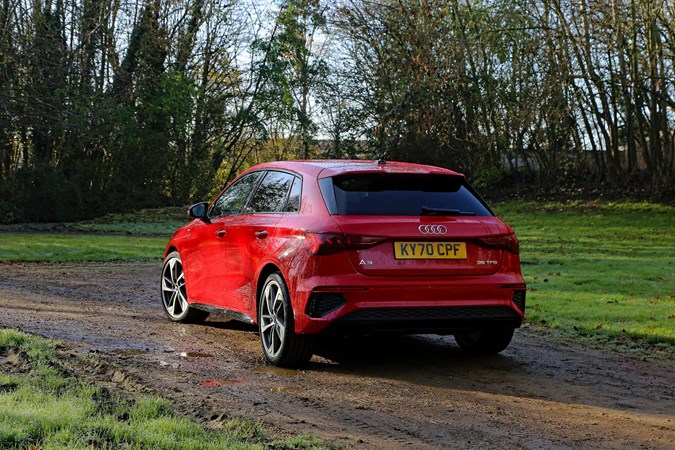
Update 2: Performance and handling
Now that we’re a month into living with the A3 it’s a good time to write about the engine. It’s loosened up nicely and is performing well. The 8.4 second 0-62mph time seems achievable, but it’s that big slug of torque (250Nm) that is the most impressive.
It kicks in from as low as 1600rpm and it means getting up to speed is effortless. It’s not fast per se, but it’s easily enough to make progress – even for such a heavy car.
One thing we should bring up – the MPG. So far, we’re not getting the claimed 50.4mpg. We’re averaging around 30-40mpg. Even on an eco trip with the dynamic drive set to efficiency, we only averaged just a smidge over 40mpg. And that’s including a 34-mile section of 50mph driving thanks to the M4.
Maybe once the engine’s worn in more we’ll see the numbers increase.
No complaints about the car’s clever two-cylinder mode. It’s virtually undetectable and it doesn’t make a fuss over it. It just seamlessly happens. The only way you’d know is that it will show you when it’s turned off two cylinders via the economy menu on the virtual cockpit.
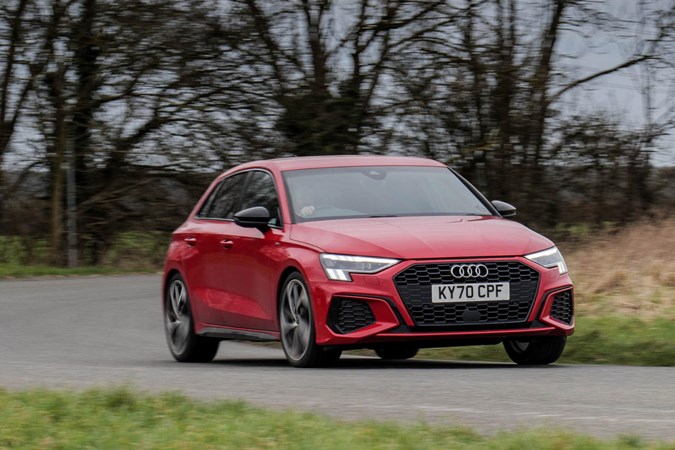
What’s it like?
That brings us nicely onto Audi’s drive select modes. There are five modes to choose from; comfort, auto, dynamic, efficiency, and individual. Each mode varies the level of throttle response and steering assist.
For instance, in dynamic the throttle response is sharp – meaning you don’t need to press the throttle pedal all that hard to achieve maximum throttle. While the steering feels precise and heavier than in other modes.
Whereas in efficiency, the throttle response is dull. You need to press the throttle right down to use it all. The steering in this mode feels light.
The driving modes do make a palpable difference. Personally I’ve opted for the individual mode, with the engine set to efficiency and the steering set to dynamic.
Broadly this A3 drives really well. It’s superbly comfortable and really well damped (even on those massive 19-inch alloy wheels) meaning it doesn’t pitch and sway on badly potholed or uneven roads, it manages to be smooth and level in most situations.
Complaints? Low speed ride is a bit fidgety. Road noise at motorway speeds is pretty unpleasant and loud (I suspect those 19-inch rims don’t help). The wireless Apple CarPlay has a habit of restarting itself one or two times on every journey.
What about the handling?
Previous Audi A3s have been a bit meh on the handling front but this one really isn’t. It’s waaaay more direct than i’d imagined.

This is brilliant news for two reasons. On the boring side of things the A3’s steering is very precise. Tight streets are easily negotiated, as are tricky mini-roundabouts.
On the slightly more exciting end of the scale, it’s a fun car to drive. There’s a real flow to the suspension on fast and winding roads, helped by this precise steering. Turn in is immediate and gives you great confidence on where to place the car. Feedback from the wheels comes through thanks to the squareish S Line steering wheel – and hell – in dynamic driving mode the steering manages to feel even more direct and even more communicative, rather than simply heavier.
A3s with 150hp or more (like mine) have a more advanced multi-link rear suspension than in less powerful models. This adds to the already polished feeling A3.
In fact, I am beginning to like the A3 so much that it leads me to ask the question – do you really need an A4?
Update 3: Comfort and interior
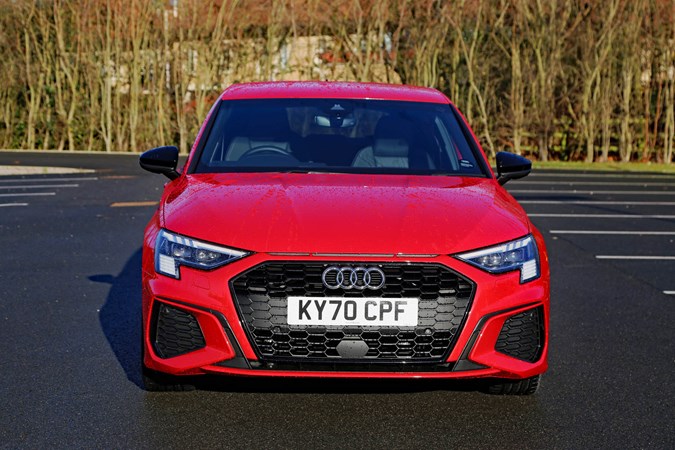
I’m gonna kick things off in this section with a gripe. The A3 can be noisy. Wind, road, and tyre rumble can all be heard prominently
The errant and irritating clatters are restricted to motorway speeds, which is a shame because it rides so well.
At 70mph the whoosh coming through the cabin is enough to make me crank up the volume on the infotainment when I get up to the national speed limit. It’s certainly louder in here than you would find in rivals like the Mercedes A-Class and BMW 1 Series.
Those 19-inch wheels don’t help. I’ve recently driven a Volkswagen Golf (more on that at a later date), which is mechanically very similar to my A3. The Golf had 17-inch wheels and was a bit quieter – although still a bit louder than i’d have thought.
Looking beyond this irritation, I really rate the interior.
The seats are trimmed in Alcantara and leather and are the right side of firm. I find them superbly comfortable over long journeys – supportive without being too tight or pinching. Seat position is spot on too. It’s neither bolted to the floor, nor oddly high. It’s a traditional hatchback height, and we say that in the best way possible.
Comfort and sound pack
My car came with the additional comfort and sound pack for £865. This includes parking assist, Bang & Olufsen sound system, heated front seats, and a reversing camera.
Should an Audi already come with a reversing camera? To me, yes. It seems stingy that you need to pay to get what is a fairly standard piece of kit.
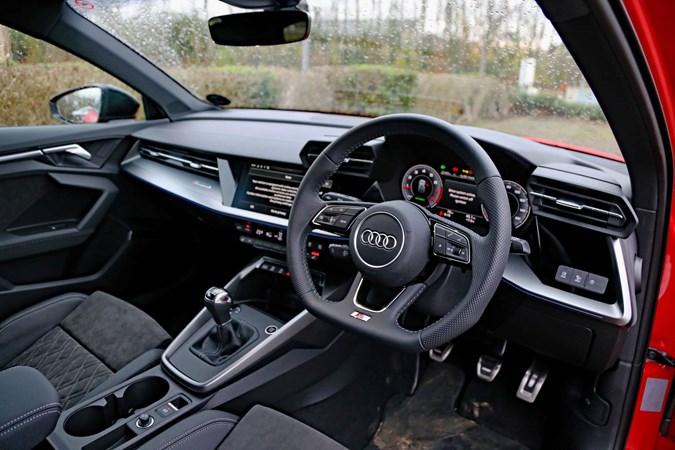
Despite that, I’d say the kit is well worth the money. The park assist is a lot quicker at finding a parking space than some other systems. It’s well worth a try if you first sampled one five years ago and found it was painfully slow. I’ve used it semi-regularly to parallel park on my tight street. It’s super simple to use, and, it’s even on a physical button rather than tucked away in a menu.
The Bang & Olufsen sound system has 15 high-performance speakers dotted around the car. It provides a very rich and deep sound. Music is very good – but like with most other systems – podcasts are a bit quieter. Anyone know why?
The heated front seats get toasty quickly, and are on physical buttons. While the reversing camera usefully has different angles.
Infotainment
The A3’s infotainment system is superb. For me, it’s slick and modern, yet, it’s juxtaposed with conventional wisdom elsewhere.
The 10.25-inch landscape infotainment screen situated on the centre console is a joy. It’s smooth, easy to read, and super crisp. Same for the driver display, which is configurable. Personally, I prefer having the dial on the left reading the RPM, the dial on the right MPH, with the space in the middle dedicated to the map.
Where it’s more traditional is in its use of buttons. There are buttons for the climate controls, the heated seats, the drive modes, the hazards, the cruise control…and they’re all exactly where you’d anticipate them being.
Audi’s sat-nav uses Google maps and is clean and simple. Instructions show up on both the main infotainment screen and driver display, which is super helpful.
The only fly in the ointment is with the wireless Apple CarPlay, as mentioned earlier on in the report. It initiates smoothly. Step into the car (with my Bluetooth on) and it syncs without me needing to do a thing. Apple CarPlay is displayed directly onto the screen. Brilliant. If my phone needs charging, I can charge it via the wireless charging pad underneath the screen. Also brilliant. Well done Audi.
Except that it occasionally has to ‘reinitialise’. This prompts a loading screen. This is annoying if you’re using the infotainment screen for directions.
What’s it like for passengers?
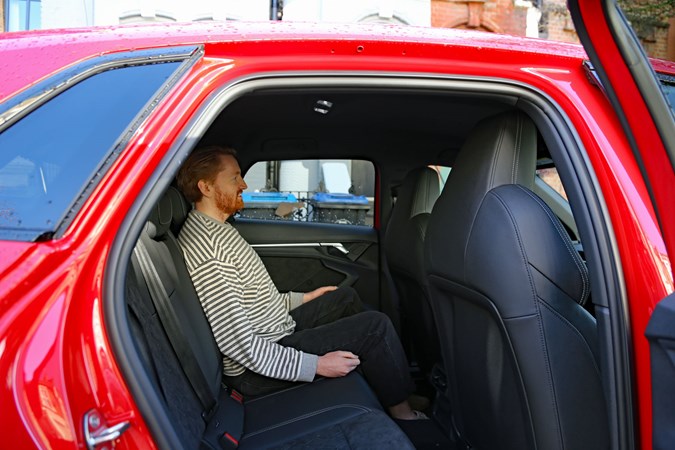
I haven’t had the chance to be a passenger in it yet, but I can confirm everyone who’s scrounged a lift off me has been very happy.
Front seat travellers have plenty of head and knee room with easy access to heating and infotainment controls.
There are no separate heating controls for rear seat passengers, but the seats are comfortable (a bit softer than the ones up front) and there’s enough knee and elbow space. Headroom might be a pinch for those over six foot.
On one occasion I went four adults up on a two hour drive. The car was packed with bags and luggage, yet, it never seemed uncomfortable for anyone.
I know things become different when you need to lug child seats and prams everywhere, but I could imagine the A3 is large enough for single child families.
While I can confirm it’s easily the right size for me – a childless adult living with a partner in a city who occasionally ferries more than one person around. I’m sure the Government has some kind of acronym to describe me, but I can’t be bothered looking it up.
Update 4: Practicality
The practicality section of this long-term report raises some interesting questions for the A3. It’s a medium-sized hatchback, a type of car that was the norm for so long in the UK.
That’s until the SUV came along. If you’ve been driving for the last 10-or-so years you will have noticed loads more SUVs on the roads.
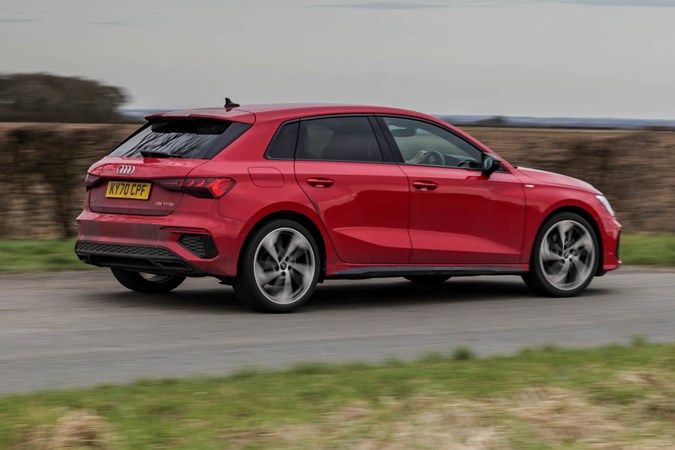
They’ve become de rigueur for family transport. To me, a full-size SUV is too big for a small family. But then again I don’t have kids.
I certainly think the A3 seems practical enough if you had one or no kids. There’s 380 litres of room in the boot, two rear isofix points with covers, and enough nooks and crannies to jam crisps into.
Childed colleagues assure me that small ones, especially really young ones, require more things than I could possibly imagine.
I will say that up front the door bins swallow one-litre bottles, as do the cupholders in the middle. The place where you stick your phone for wireless charging is also well done. There’s a mat that holds my phone just so. The phone is aimed away from you too – unlike with a Tesla Model 3.
The only area it really lets itself down is in how far the rear doors open. They don’t open very wide. I imagine this makes sticking children and their accompanying seats in the rear a pain.
Where you sit on the SUV fence depends on how much you really value practicality. A similarly specced Audi Q3 (Audi’s medium-sized SUV) is around £10,000 more in cash, or about £130 a month more on similar PCP deals than my A3.
The Q3 is taller, with wider opening rear doors, and more boot space (530 litres). But it does make you think – is that extra space really worth £1,560 per year?
What’s the bootspace like?
As mentioned above, the boot measures in at 380 litres (or 1,200 litres) with the rear seats down. This is pretty much on par with both the Mercedes A-Class and BMW 1-Series, although the boot opening for the A3 is narrower than either.

It’s been up to the task of anything I’ve been able to throw at it. Oddly, despite being a high-specced launch edition model it’s missing an electrically opening boot.
These are pretty practical when your hands are full and you want to summon the boot by sweeping your foot underneath it.
Parking
Good news – the A3 is easy to park. The mirrors are large and well placed. The view out the back is just ok. Put that down to the slightly sloping rear end.
For me, how easy a car is to park is a big sell. Especially because I live on a terraced street where I normally have to parallel park.
> Skip back to the bit where I write more about the A3’s park assist feature
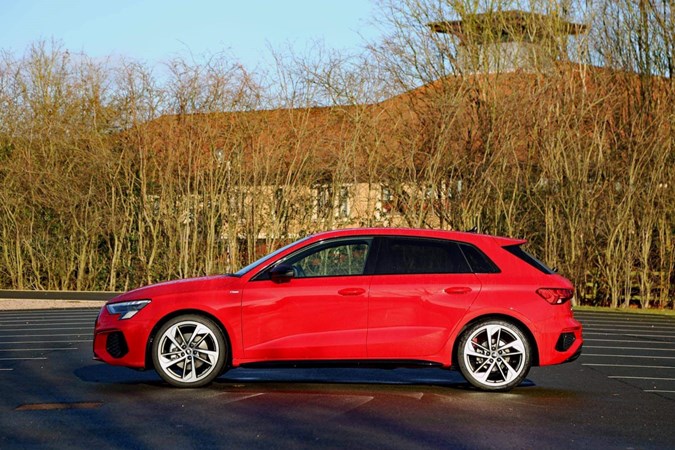
Update 5: Head-to-head with the VW Golf and A3 PHEV
On test: VW Golf 2.0-litre TDI R-Line and Audi A3 Sportback 40 TFSI e S line
TL;DR – the A3 feels noticeably better than the Golf. The doors feel heavier, the infotainment screen is just that bit slicker, and the interior layout is less frustrating.
TL;DR – the plug-in hybrid A3 is a very good prospect for a select few people. We’d recommend a petrol or diesel A3 for the majority.
It’s about time we put the A3 against some rivals. I’ve chosen the Golf because underneath the surface they’re very similar. While I’ve also pitched it against an alternatively fueled A3, the plug-in hybrid 40 TFSI e.
>> Want to know what it’s like against BMW and Mercedes? Read our A3 versus BMW 1 Series versus Mercedes A-Class group test
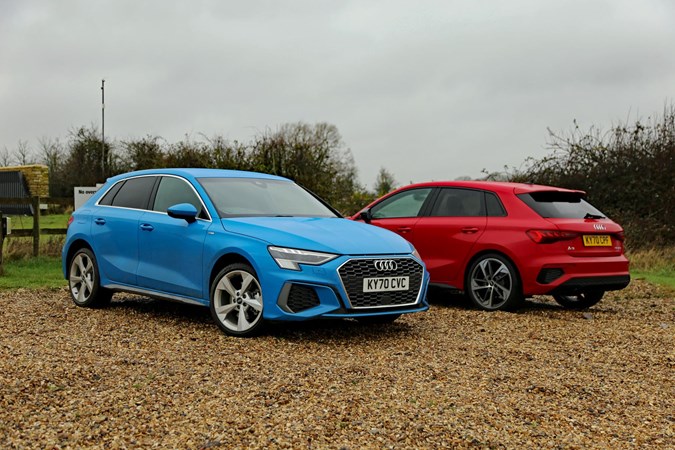
Styling
First round goes to the A3. Of course, styling is subjective, but for me the A3 has a lot more panache than the Golf. The side profile especially. There’s a deep downwardly sloping crease that runs along the bottom that comparatively makes the Golf look a bit blobby and unathletic.
Saying that, the 19-inch wheels on my A3 can be seen as a bit try-hard. I say the Audi looks tauter and more powerful, but that can be seen as aggressive, too.
The plug-in A3 only differs with my petrol one by having different wheels and badges.
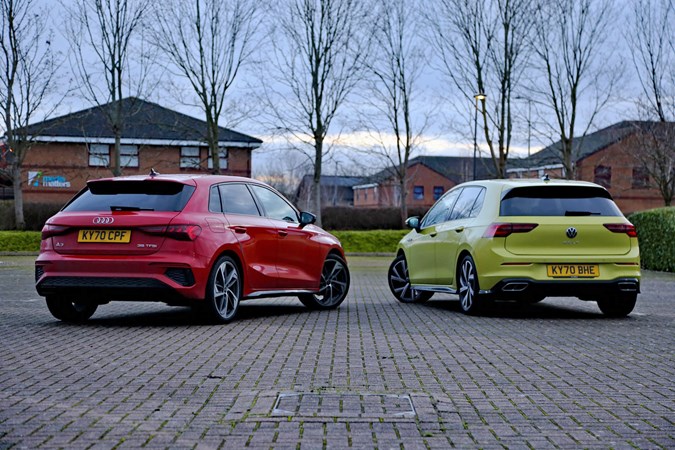
Interior
Here’s where the Volkswagen Golf (pictured) falls most behind the Audis.
Volkswagen insists on a clean and minimalist interior for the Golf. This means it has very few physical buttons. The heating controls are touch surfaces. I appreciate that it’s clever, but it just doesn’t feel as intuitive or as simple and easy to use as the ones in the A3. I certainly had to make a few stabs at adjusting the heating in the Golf.
The infotainment screens look and feel pretty different despite the fact they broadly do the same kind of thing. For one, the Golf’s infotainment screen is joined up with its digital dials, whereas the A3’s aren’t.
The main infotainment screen in the Audi goes right to the outer limit of the casing (like a high-end phone) whereas the Golf’s doesn’t, and that just makes it look and feel a bit cheaper.
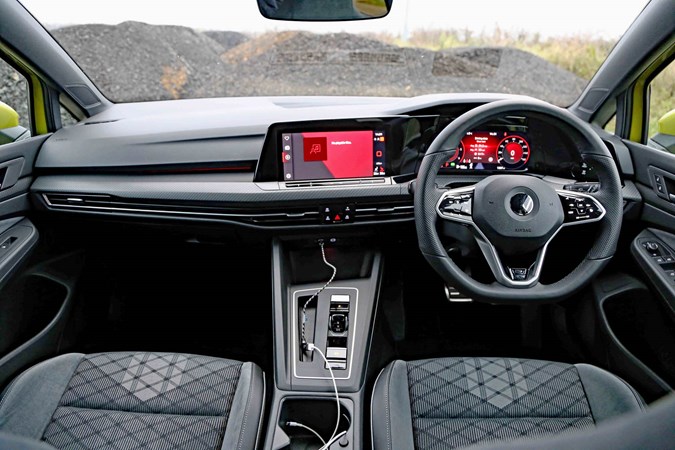
Away from the tech the A3 continues to win. Moving the Golf and A3 around for the pictures means getting in and out of cars multiple times. After 30 mins of this you can really tell the A3’s door feels heavier and close with a more reassuring thud. This kind of thing is built in to make consumers notice palpable differences and it really works.
Practicality
Finally, somewhere where the Audis are different. To accommodate the electrical gubbins the boot is smaller in the plug-in A3. Boot capacity drops from 380 litres to 280 litres. That makes quite a bit of difference.
My regular A3’s boot isn’t all that big. The plug-in hybrid’s usable boot space shrinks down to a supermini size. That suddenly turns the A3 plug-in from a usable car for a small family, to only really suitable for those without kids.
The Golf’s boot size is identical to the A3’s at 380 litres. Space in the back is basically the same for all three cars.
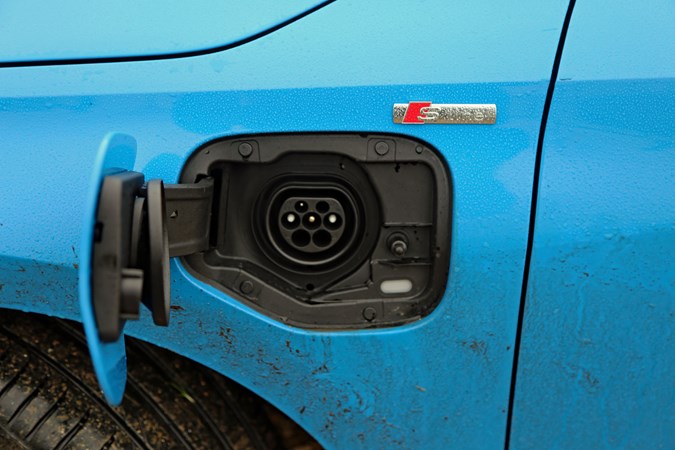
We should mention here that the plug-in takes around four hours to charge from a domestic wallbox.
Driving
This is where the three cars are the most different. The Golf is a diesel, my A3 is a petrol, and the blue A3 is a PHEV.
Unsurprisingly the A3 PHEV feels the most different. It has a 1.4-litre petrol engine and an electric motor. Combined power is 201hp. It feels much quicker than my 1.5-litre petrol A3. Official electric range is 40 miles. We reckon it’s more like 30-32 in real world driving.
Default mode is fully electric. It trickles along nicely in this mode. It’s super-smooth and quiet and is a really lovely thing to pootle around in. If you have a home charger and rarely venture more than 40-50 miles you can expect MPG in the hundreds.
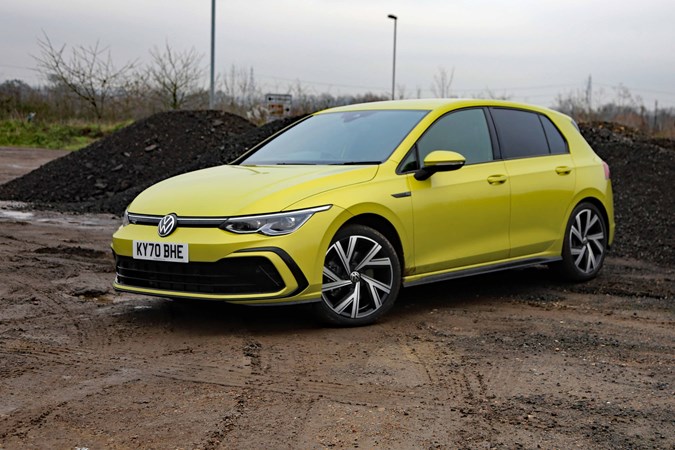
In many ways the diesel is quite similar to the plug-in car. Like a lot of other diesel engines, it’s punchy and effortless, although a bit louder and not as clean as the other two. Ofcourse, getting energy into the diesel requires very little effort. Fill up and expect mpg in the 60s from the 150hp 2.0-litre engine. No waiting around for it to charge.
The 1.5-litre petrol in my A3 is the goldilocks of the three. It’s less agricultural sounding than the diesel, but not as quiet as the plug-in. It is noticeably slower than either.
Pricing
Base price: Audi A3 Sportback Edition 1 35 TFSI – £30,525
Base price: Audi A3 Sportback 40 TFSI e S line – £34,245
Base price: VW Golf 2.0-litre TDI R-Line DSG – £29,915
We won’t go into individual finance figures because they become out of date almost instantly. At time of writing VW was offering a £1,250 deposit contribution and 4.9% APR, while Audi was offering a £1,000 deposit contribution and 5.1% APR.
In other words, the finance and pricing is close. Really close.
Group test verdict
Golf or A3? Audi for me please. The added value I get from the Audi over a Volkswagen is worth the slight increase in price. Even over a week I never gelled with the Volkswagen’s infotainment – while the Audi just feels like a more polished product.
I’d pick the petrol A3 over the plug-in too. The plug-in is a niche product, brilliant for people who can regularly charge and don’t travel far. But the loss of boot space really hampers its everyday practicality.
Update 6: Would I recommend one?
To gauge how good this car is, there’s one question to answer. Would I recommend an A3 to a friend? Well I would, and I have.
For me, the A3 sums up what small Audis do best. They bring you a premium quality product in a neat and desirable package.
It looks superb. The detailing along the side is especially rakish. I’d recommend the Tango Red modelled on my car. It shimmers with the detailing in the right light.
The Matrix LED headlights are ever so slightly different depending on which model A3 you go for. They work brilliantly.
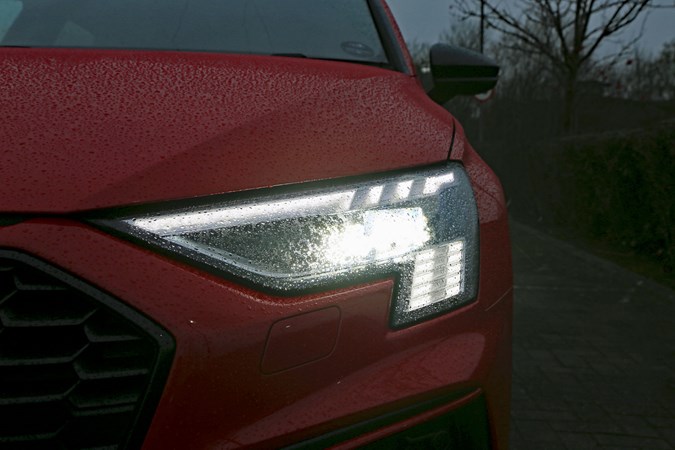
It’s practical enough for my needs as a childless city-dweller. And it bosses the motorway too.
Towards the start of this piece I complained about the fuel economy. I was only getting 30mpg at one point, but things really improved as the engine bedded in. Over my six months with the A3 I averaged 49mpg. WLTP official figures for the car are 50.4mpg – so to get within 1.4mpg is astonishing. On the motorway it really slips into its two-cylinder mode with ease – which explains the stellar mpg.
The thing that surprised me most in my six months with the Audi is what it felt like compared with the VW Golf. The Audi is just such a step above. The quality of nearly everything you touch is palpably better. And the infotainment and controls are easier to use. Of course mechanically the two cars are very similar, but how much do people really care about that?
I don’t think there is a bad trim or engine in the lineup of A3s. I questioned whether the 35TFSI (150hp) was enough for a car weighing 1400kg, and it definitely is. It doesn’t pull from low rpm as well as a 2.0-litre diesel, but there’s not much in it. I’ve never wanted more power in day-to-day driving.
The PHEV is the most niche. Not necessarily a criticism of Audi, just of plug-ins in general. If you really think a plug-in suits your lifestyle – the A3 is a pretty good one.
Annoyances, there have been a few. Road noise is high, especially at 70mph. The rear doors are narrow. That doesn’t annoy me because I’m always driving. But it would be irritating if I had a baby, a baby seat, or any combination of the two.
Audi A3 long-term reliability
During my six months there were no real causes for concern. It’s never once failed to proceed, nothing has broken, and not one thing has come off in my hand despite prodding and poking.
However, the wireless Apple CarPlay function cuts out at least once every journey. And occasionally I’ll get an SOS emergency call function fault flash up on the screen, which usually fixes itself straight away.
Final thoughts
If you’ve read through this entire page you’ll understand that I really rate the A3. I like it so much that I’d have one over a more expensive Audi A4. Sure the A4 is more practical and quieter on the motorway, but if you don’t particularly need a big boot I’d go for an A3 and pocket the money for a holiday.
‘Paying for the badge’ is bandied around with gay abandon in the car world where lots of different models share mechanical componentry. But you won’t feel short changed from choosing this premium car.
I’ll miss it greatly.
